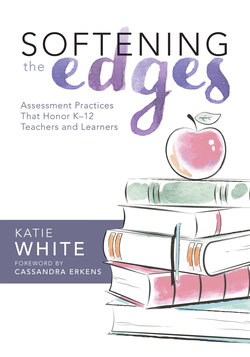Читать книгу Softening the Edges - Katie White - Страница 7
ОглавлениеForeword
By Cassandra Erkens
As educators, we have often heard about the art and science of teaching, but we have seldom considered the art and science of assessing. If anything, assessment has been a largely clinical task, shrouded in technical discussions, and a predominantly scientific endeavor laced with designing perfect prompts, gathering sufficient evidence, triangulating data, validating inferences, monitoring for controls and variables, and drawing accurate conclusions. But in Softening the Edges: Assessment Practices That Honor K–12 Teachers and Learners, author Katie White masterfully reshapes the face of assessment to be as much an art as it is a science.
The Science of Assessment: A Fresh Perspective
Assessment includes technical aspects that we cannot ignore. Much has already been written about the granular details of how to accurately design and effectively use classroom assessments (for example, Ainsworth, 2003; Black & Wiliam, 1998; Stiggins, Arter, Chappuis, & Chappuis, 2004; Vagle, 2015; Wiggins & McTighe, 2005). White contributes to this field and offers a fresh perspective on the extant literature. Specifically, she helps her readers integrate critical concepts with practical examples, meaningful questions, and applicable strategies.
Softening the Edges offers educators a comprehensive yet accessible path for navigating the assessment process from start to finish. White helps teachers integrate important concepts in the field by showing her readers the connections. Using stories, charts, reflective questions, and examples, she illuminates the tight relationships between assessment and instruction, precision and flexibility, formative and summative assessment, and, most importantly, student learning and teacher learning throughout the assessment process.
As she navigates the details of assessment development, White provides concrete ways to implement the work. She argues that targets are more than statements of what students will learn, and they are more than indicators for assessment development—targets inform the instructional actions teachers must take to make the learning visible and available to the learners. White illustrates learning continuums that illuminate the connections among targets, learning progressions, proficiency levels, and specifically, the reflective questions teachers must use to guide instructional decisions when moving all learners forward. White’s handling of the nuts and bolts of assessment helps teachers delve deeper so they can integrate assessment practices in meaningful ways.
While addressing the technical aspects, White reminds us to challenge our own assessment work. This is a field, she notes, that does require precision but in the context and service of building hope and efficacy for our learners. She writes:
If we believe an assessment has fallen short, we may consider using that evidence as formative evidence only and seek more information in a different way. If each assessment was strong, we may begin to ask ourselves, “Did the learners struggle with a particular piece the first time, and do we know this learning gap was addressed the second time?” If so, then the most recent evidence is the most reliable. (page 177)
The evidence we ourselves generate through the assessment process must sometimes be further investigated or impeached. In this, and so many other ways, Softening the Edges provides clarity to many misunderstandings within the science of assessment.
For far too long, debates regarding formative and summative assessment have raged in the field (Can formative assessments be graded? Are summative assessments the end of learning? If one is better, why is the other even necessary? and so on). With this fresh look at assessment, White renders the debates meaningless. She argues that the issue has little to do with the mechanics of assessment and everything to do with the human dynamics involved in the assessment process.
The Art of Assessment: The Master’s Landscape
From the seemingly insignificant comment a teacher might share in passing to the influential test score a teacher will ultimately assign, assessment is deeply personal. Throughout Softening the Edges, White reminds us that assessment work is human work. She writes, “We bring our own humanity to our learning spaces and there, we meet human learners…. Together, students and teachers can co-construct conversations and experiences that impact us well beyond our time together in the classroom” (page 12). With humanity squarely in the center of our work with students and learning, there can be no hard lines in the art of assessment.
Like an artist with a canvas, White uses personal stories, metaphors, and imagery to contextualize important concepts. Her poignant illustrations help readers put empathy back into an assessment routine that can be sterile and sometimes heartless. As early as chapter 1, White reminds us that “Students … are complete and changing, just like adults” (page 14). And throughout the book she reminds us that teachers, like students, can also learn and evolve through the assessment experience: “We need to become comfortable with ourselves as professionals. We need to trust our observations. Once we do, we are free to experiment with learning experiences. We can move beyond paper into a three-dimensional world” (page 90). Like art, assessment makes life infinitely richer for everyone involved. It must be functional, yet aesthetically inviting. It must remain responsive and continue to evolve.
Painter Georges Braque (1952) once noted that science is meant to reassure, but art is meant to disturb. The true art behind Softening the Edges lies in the author’s ability to gently but rightfully disturb the traditional assessment arena in which students and teachers alike have been prematurely and thus wrongfully labeled and judged. Instead, assessment must remain open to discovery and possibility. It is about uncovering insights into the self while discovering truths about the world around us. We must rethink our work with assessment, White contends, softening our hard lines of monitoring, measuring, scoring, evaluating, and moving on. She builds the masterful argument that we must slow down enough to enjoy the journey and relax enough to appreciate the gifts we find in each other along the way. In the end, assessment must support the human endeavor to learn and love.
